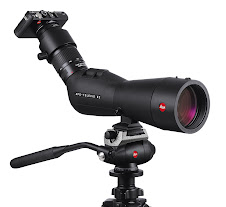Each year, I eagerly await my early spring trek to Galveston, TX for the annual FeatherFest bird festival. I know I will see plenty of wonderful wading birds, shorebirds, and many of the first spring migrants returning from Central and South America to breed.

Reddish Egret, white morph, digiscoped in Galveston, TX 4/09
Even living in Florida, I can't help but appreciate long-legged wading birds both for their beauty and their willingness to pose for imaging! The white-morph of the Reddish Egret is comparatively common on the West side of the Gulf of Mexico in Tx as compared to my home on the Eastern edge of the Gulf. As such it is always great to see these birds when I'm here. The bird above was photographed with a warm early morning light washing it from one side, providing a nice mix of shadow and warm golden highlights.
 Yellow-crowned Night-Heron, digiscoped Galveston, TX 4/09
Yellow-crowned Night-Heron, digiscoped Galveston, TX 4/09Yellow-crowned Night-Herons are nocturnal (more active at night) as the name implies and prefer coastal locations. They are commonly found roosting by day in mangrove bushes. The bird above is a good example of the effects of lighting in digiscoping. This image was taken after the sun had set. While I got the image, this lighting does seem to produce some odd colors not typically seen on an image taken with more and direct lighting. The camera captured an unusual rosy bloom on the belly of this bird and the steel gray back feathering is a bit too blue. With a bit more light this bird's colors would be depicted more accurately.

Green Heron digiscoped with Leica APO Televid 82 spotting scope & D-Lux 4 camera
In the image above the Green Heron was wading through a shadowed marshy area washed in direct evening light. Note the difference that direct low-angle lighting makes. The colors are vibrant and true. Photographers love this "sweet light" found within an hour or two of sunrise and sunset respectively.
 Green Heron digiscoped image, Texas 4/09
Green Heron digiscoped image, Texas 4/09
From Galveston, it is a mere hop, skip, and jump (and a ferry ride) to famed High Island known far and wide for the wondrous number and variety of migrant songbirds that can occur here in spring. Fortunately, when the weather is not right to promote good migrant watching the local rookery full of Roseate Spoonbills is a great consolation!
 Roseate Spoonbill, digiscoped @ High Island, TX 4/09
Roseate Spoonbill, digiscoped @ High Island, TX 4/09The birds here are often a bit distant for a lot of camera rigs, but digiscoping offers an ideal focal length. These Spoonbill images were all taken at near 1,500 mm lens equivalent.

Roseate Spoonbill digiscoped w/ Leica APO Televid 82 mm scope & D-Lux 4 camera
The bird above has not yet adopted the greenish head typical of full adult-plumaged birds and despite its considerable color is still comparatively dull.
Roseate Spoonbill adult in high breeding condition ,High Island, TX 4/09
Note the difference in color on the adult above showing the dark pink "shoulder", and "beard", lime green cap, and bright yellow facial skin. It even shows a bright orange tail (as if it weren't colorful enough).
Roseate Spoonbill digiscoped w/ Leica APO Televid 82 mm scope & D-Lux 4 camera
One good feather ruffle and it's time to attract a mate!
 Roseate Spoonbill pair digiscoped in evening light, High Island rookery, TX 4/09
Roseate Spoonbill pair digiscoped in evening light, High Island rookery, TX 4/09
A pair of adults are now ready to get down to business.

American Alligator digiscoped @ High Island, TX 4/09
To help dissuade short-lensed photographers from attempting to reach the rookery island there were no fewer than 2 dozen Alligators hanging out below the nesting areas!

Alligator digiscoped w/ Leica APO Televid 82 mm spotting scope & D-Lux 4 camera
Seriously, they really were there but undoubtedly these patient creatures were simply waiting for the breeding season to kick off in earnest so the easy meals will follow. Is it me or do these birds seem to be overly pink on the insides of their mouths?... I wonder if it's their diet?... ;p


 Green Heron digiscoped image, Texas 4/09
Green Heron digiscoped image, Texas 4/09









I love the photos and just found your blog. I will visit again!
ReplyDelete